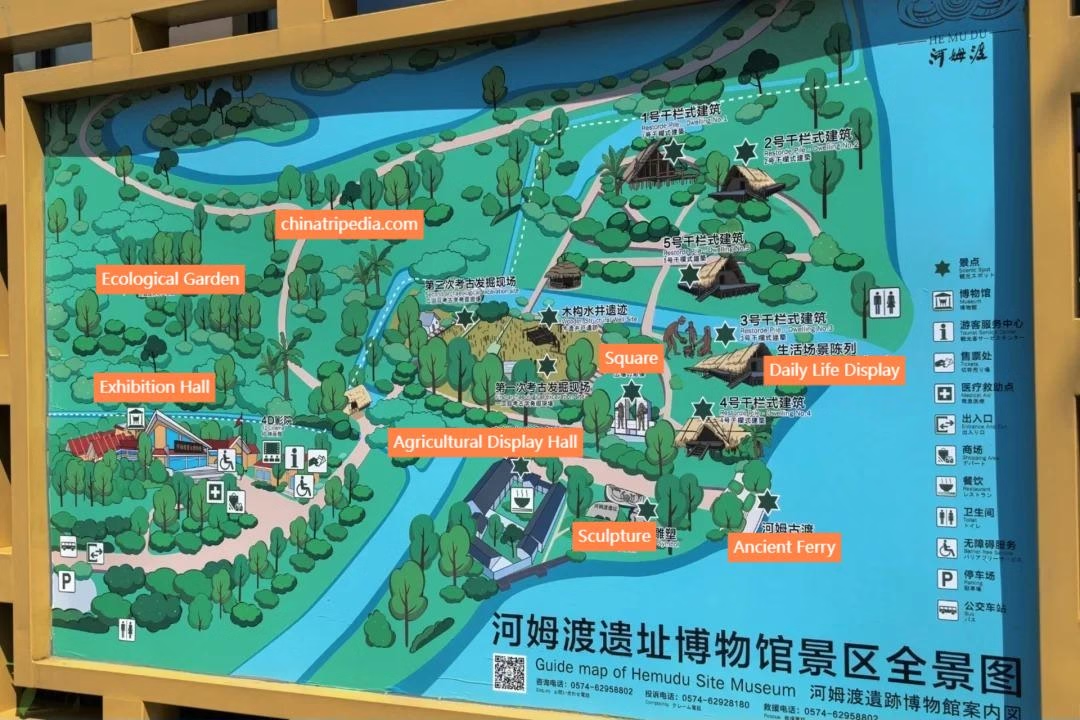Hemudu Site Museum (河姆渡遗址博物馆) showcases the remnants of an early Neolithic settlement dating back approximately 7,000 to 5,000 years ago in southern China. Spanning an area of 40,000 square meters, the site consists of four cultural layers, each representing a distinct period of human history. The fourth cultural layer, dating from around 7,000 to 6,500 years ago, stands as one of the earliest known Neolithic strata in China. The layers beneath it chronicle the gradual evolution of human civilization during this period, with the third, second, and first layers corresponding to successive periods from approximately 6,500 to 5,000 years ago.
Remarkably preserved within these layers are a plethora of artifacts, including plant remains, animal bones, traces of wooden structures, and thousands of pottery, bone, stone, and wooden artifacts. These artifacts offer invaluable insights into the daily life, technology, and cultural practices of the ancient inhabitants of the Hemudu site.
The discovery of the Hemudu site has significantly contributed to the understanding of Chinese history and archaeology, providing evidence that the Yangtze River Basin was a vital cradle of early Chinese civilization. The museum serves as a window into this ancient world, allowing visitors to explore the rich cultural heritage of the Hemudu people and their contributions to the development of Chinese civilization.
Table of Contents
- Basic Information
- Location and Transportation
- Map of Hemudu Site Museum
- Exhibitions in Hemudu Site Museum
- Vlog about Hemudu Site Museum
- Other Museums in Ningbo
Basic Information
| Estimated Length of Tour | 1 – 2 hours |
| Ticket Price | Free |
| Opening Hours | 8.30 – 17.00 (1st May – 30th September) 9.00 – 16.30 (1st October – 30th April) Closed on Mondays |
| Telephone Number | 0086-0574-62963731 |
Location and Transportation
The Hemudu Site Museum is located on the southern bank of Hangzhou Bay, at the foothills of the Siming Mountains, along the Yao River in Hemudu Town, Lushan Temple Village, Yuyao City, Ningbo, Zhejiang Province, China.
To get there, you can first take a high-speed train to Yuyao City and then transfer to a taxi to cover the remaining 30 kilomters, which costs about 100 RMB. Alternatively, you can also take bus Yuyao 515 or Yuyao 603 and get off at Hemudu Site Stop (河姆渡遗址站).
Map of Hemudu Site Museum

Exhibitions in Hemudu Site Museum
General Overview of the Site

The first hall introduces visitors to the general overview of the site, displaying excavated remains of flora and fauna, as well as reconstructed human skulls and facial reconstructions of Hemudu inhabitants. Through photographs, charts, and models, visitors gain a comprehensive understanding of the site’s significance and basic characteristics. Of particular note is a 100-square-meter model depicting the “Eco-environment of Hemudu 7,000 Years Ago.” Controlled by automated systems of sound, light, and electricity, this model vividly recreates the daily lives of Hemudu’s ancient settlers engaged in settled agricultural practices, hunting, and other activities, offering a lifelike portrayal of their environment and lifestyle.
The exhibition also showcases a diverse array of animal bones unearthed from the site, representing 61 different species. Fragments of bird, fish, reptile, and mammal skeletons on display paint a picture of Hemudu’s ancient ecosystem – a lush forest teeming with wildlife, including tigers, elephants, birds, and fish, presenting a vibrant snapshot of the ancient animal kingdom flourishing 7,000 years ago.
Rice Economy

The second hall of the Hemudu Site exhibition, titled “Rice Economy,” sheds light on the agricultural practices of rice cultivation and the supplementary activities of fishing, hunting, and gathering. On display are artifacts showcasing the cultivation of rice grains, including 7,000-year-old artificially cultivated rice grains, with clear husks and plump kernels that astonish visitors. Additionally, visitors can view a complete set of agricultural and processing tools such as bone sickles, wooden pestles, stone millstones, and stone balls used in rice farming.
Also exhibited are pottery fragments containing carbonized rice grains and a variety of cooking, dining, and storage vessels predominantly made of black pottery, including pots, bowls, plates, beans, basins, jars, ladles, cauldrons, and basins. These artifacts indicate that by 7,000 years ago, the dietary habits of the Eastern people, including the Hemudu inhabitants, had already taken shape, with rice cultivation serving as a significant economic activity. Their culinary culture had become quite rich and diverse.
Despite the advancement of agriculture, the Hemudu people still relied on fishing, hunting, and gathering to supplement their needs. Displayed hunting and fishing tools such as bone whistles, bone arrowheads, and pellets, along with an array of fruits like jujubes, acorns, water caltrops, and water chestnuts, underscore the importance of these activities in the daily lives of the Hemudu people.
Settled Life and Primitive Art

The third hall of the Hemudu Site exhibition showcases the themes of “Settled Life” and “Primitive Art” of the Hemudu people. On display are remarkable wooden components of pegged mortise-and-tenon structures, hailed as architectural marvels in history, alongside various processing tools. Additionally, a diverse array of textile tools is exhibited, showcasing the advanced textile technology of the time.





The museum is okay, with some artifact exhibitions, although it’s a bit small. The exterior, however, is quite disappointing. They claim there are five wooden fence structures, but only one is open. Inside, it’s messy and dirty. Is this supposed to recreate the authentic scene of ancient times?
The Hemudu Cultural Site Museum can be described as small yet exquisite. The exhibits are quite captivating, featuring ancient production tools and daily necessities, such as sewing needles. There are also ritual items with artistic patterns, and even toys for children. A long display screen in the exhibition case uses animations to visually demonstrate the purposes of these artifacts from back in the day, making it easy to understand. Once you exit the museum, you can visit the excavation site… Read more »
Just took a casual stroll around, and the scenery inside is quite nice. It’s just that the museum itself is a bit small.